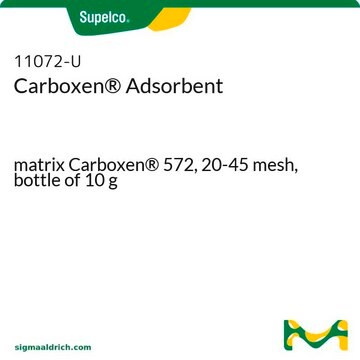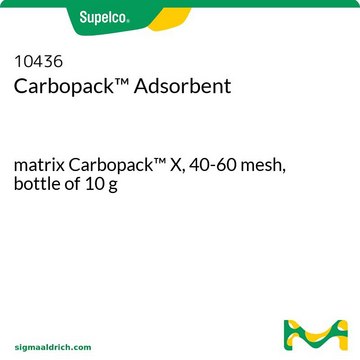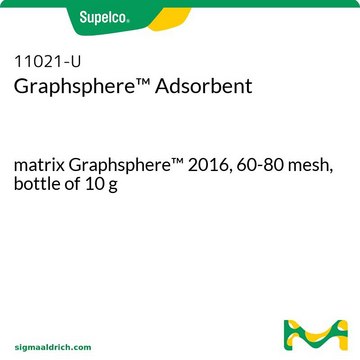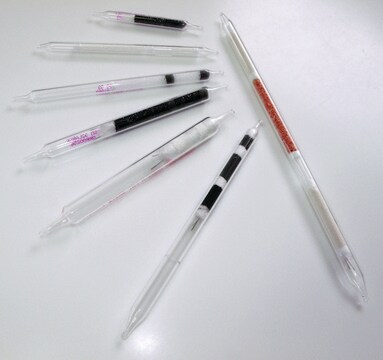10477-U
Carboxen® Carbon Adsorbent
matrix Carboxen® 1000, 40-60 mesh, bottle of 50 g
Sinónimos:
carbon adsorbent, GCB, 60-80 mesh
About This Item
Productos recomendados
product name
Carboxen® Adsorbent, matrix Carboxen® 1000, 40-60 mesh, bottle of 50 g
Línea del producto
Carboxen®
formulario
powder
envase
bottle of 50 g
técnicas
LPLC: suitable
superficie
~1200 m2/g
matriz
Carboxen® 1000
grupo activo de la matriz
carbon
tamaño de partícula
40-60 mesh
tamaño de poro
~0.16 cm3/g mesoporosity
~0.25 cm3/g macroporosity
~0.44 cm3/g microporosity
~10-12 Å pore diameter
densidad
~0.50 g/mL (free fall density)
técnica de separación
reversed phase
¿Está buscando productos similares? Visita Guía de comparación de productos
Descripción general
Aplicación
- Evaluation of selected solid adsorbents for passive sampling of atmospheric oil and natural gas non-methane hydrocarbons: This study assesses different adsorbents including Carboxen for capturing non-methane hydrocarbons in the air, crucial for environmental monitoring and regulatory compliance (Helmig et al., 2022).
- Application of Thin-Film Microextraction to Analyze Volatile Metabolites in A549 Cancer Cells: Discusses the application of Carboxen adsorbents in microextraction techniques for analyzing volatile compounds from cancer cells, demonstrating its utility in medical research and diagnostics (Filipiak et al., 2021).
- Analysis of volatile organic compounds in indoor environments: The study uses Carboxen adsorbents for sampling and analysis of indoor air pollutants through gas chromatography, highlighting its application in improving indoor air quality and health (Veenaas et al., 2020).
- New approach to resolve the humidity problem in VOC determination in outdoor air samples: This research addresses challenges in using Carboxen adsorbents for environmental VOC sampling, emphasizing improvements in the accuracy of air quality assessments (Maceira et al., 2017).
- Measurement of breakthrough volumes of volatile chemical warfare agents on a poly(2,6-diphenylphenylene oxide)-based adsorbent: This paper evaluates the efficiency of Carboxen adsorbents in capturing chemical warfare agents, indicating its potential in security and environmental protection applications (Kanamori-Kataoka et al., 2015).
Características y beneficios
- Spherical
- Hard (ball pan hardness >98%)
- Stable up to 400°C
- High purity
- Easy to pack
- Stable over entire pH range
- Do not create backpressure
- High osmotic shock stability
- Tapered pore sizing (from macro- to meso- to micro-)
Otras notas
Información legal
Código de clase de almacenamiento
11 - Combustible Solids
Clase de riesgo para el agua (WGK)
nwg
Punto de inflamabilidad (°F)
Not applicable
Punto de inflamabilidad (°C)
Not applicable
Elija entre una de las versiones más recientes:
Certificados de análisis (COA)
Lo sentimos, en este momento no disponemos de COAs para este producto en línea.
Si necesita más asistencia, póngase en contacto con Atención al cliente
¿Ya tiene este producto?
Encuentre la documentación para los productos que ha comprado recientemente en la Biblioteca de documentos.
Los clientes también vieron
Artículos
Carbon Molecular sieves (CMS) are a versatile range of adsorbents that can be tailored for specific applications. Supelco® scientists have been synthesizing synthetic CMS carbons for several decades, starting from tailoring of the starting polymers/copolymers, to modifying the final properties of the subsequent CMS carbon.
Nuestro equipo de científicos tiene experiencia en todas las áreas de investigación: Ciencias de la vida, Ciencia de los materiales, Síntesis química, Cromatografía, Analítica y muchas otras.
Póngase en contacto con el Servicio técnico













